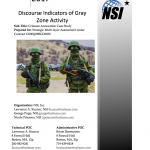Discourse Indicators of Gray Zone: Crimea

Discourse Indicators of Gray Zone Activity: Crimean Annexation Analysis Case Study.
Author | Editor: Kuznar, L., Popp, G. & Peterson, N. (NSI, Inc).
The increasing use of emotive themes and rhetorical devices (that amplify a message’s emotional effect) provide indicators of gray zone activities in speeches made by Eurasian regional leaders prior to and during the annexation of Crimea. Putin’s leading indicators, those of Crimean leaders and the Russian-supported President of Ukraine, Viktor Yanukovych, are presented separately.
Indicators & Warnings (I&W)
The primary findings regarding Russian government leading indicators are focused on Putin and include:
- As a general pattern, Putin is more restrained in his language than most Western leaders, making indicators of his intent rare.
- The rarity of these indicators increases the ability to detect them as statistical “blips” in his language use; a thing that rarely appears is noticeable when it occurs.
- When Putin mentions key emotive issues, they occur suddenly as a “blip” in his general discourse in advance of operations. However, he is disciplined in subsequently silencing himself during apparent planning and execution phases.
- However, once his goal is achieved, he relaxes his restraint and releases a rhetorical flourish of concerns and emotional language (a “brag”).
- After a rhetorical flourish, Putin again restrains his discourse when planning and executing operations to achieve his next strategic goal.
- The blip patterns that may be detected are manifest in emotional themes such as Pride, Protection, Unity, Strength, and Russian Superiority, and political themes such as Russian Security, mentioning Adversaries, Russian Energy, and the Ceasefire.
- Putin exhibits a sustained and increasing apparent concern with Russian Energy Resources and the Threat of Nazism, consistent with earlier studies.
- Putin is demonstrating an increasing concern with Turkey, which may have direct implications for his intentions in Syria.
The primary findings regarding Crimean leaders and government include detectable blips approximately a month and a half before the annexation in emotive themes that include:
- Fear of Extremism, Failure of the Ukrainian government (an enemy), desire for Stability, Independence, Legitimacy of Crimean cause, Unity of Crimeans, Separatism, Sovereignty for Crimea, a sarcastic claim to be open to Cooperation, and use of the rhetorical device of Accusation.
- There is a curious “blip and brag” pattern in the mention of the ingroup (Crimea), their friend (Russia) and primary enemy (Ukraine).
Russian-supported President of Ukraine Viktor Yanukovych
- There were no detectable leading indicators for the Russian-supported Ukrainian President Viktor Yanukovch, but this may be due to the fact that his speeches ended four months before the annexation of Crimea, and perhaps more relevantly, Yanukovych may have had more pressing concerns as his hold on power was failing at this time.
Predominant Concerns of Regional Actors
- The pervasive concerns of the Putin government were Economics and Trade, not expansion, Russian imperialism, or national pride.
- The pro-Russian President of Ukraine, Viktor Yanukovych, expressed views identical to those of the Putin government, indicating his ideological alignment, if not direct control, by the Kremlin.

Comments